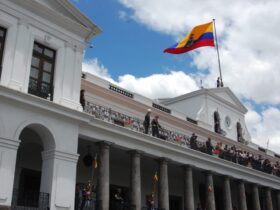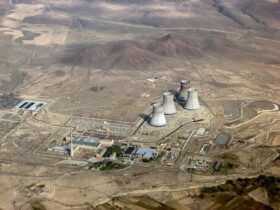LOS ANGELES — The 26th Conference of Parties (COP) to the United Nations Framework Convention on Climate Change (UNFCCC) is an annual United Nations sanctioned conference focused on climate change which all UN member states are invited to attend. COP26 is currently underway, running from Oct 31. to Nov 12. in Glasgow.
COP is hosted this year by both the UK and Italy, with the latter serving primarily as a logistics and planning hub for the main event. Initially planned to take place in 2020, COP26 was postponed a year due to the COVID-19 pandemic. With several heads of state and other important representatives from 197 countries in attendance, COP26 plays a key role in determining the actions, commitments and strategies that the international community will take to mitigate climate change.
The presence of several world leaders could also lead to more firm and swift actions taken to fight climate change. Gathering all the UN countries for a focused and uninterrupted discussion on the topic, with the common goal to coordinate climate change commitments – a diverse assortment of policy proposals including carbon emission reduction, technological innovation, sustainable development strategies and more – to achieve significantly more progress than any individual national action could.
Although this is an annual event, this year marks five meetings since COP21, more popularly known as the Paris Climate Conference that produced the landmark Paris Climate Agreement. Furthermore, COP26 will be the first time that short-term commitments, known as “nationally determined contributions” (NDCs), will be evaluated and renegotiated since states initially pledged at the Paris Climate Conference.
Structuring Sustainability Commitments
NDCs outline the goals each country aims to address, especially regarding current emission levels, and specify their contribution to climate change mitigation and adaptation. The goal of this process is that, every five years, countries will ramp up their goals and take progressively larger leaps toward net-zero emissions and an environmentally sustainable economy. This process is colloquially called the “ratchet mechanism,” as countries collectively amplify their commitments over time.
Countries were able to submit these new statements starting at the beginning of 2020, and as of the beginning of the conference, 149 countries had uploaded new or updated NDCs. These account for 78% of the Paris Accord signatories and 80% of the world’s CO2 emissions. However, not everyone has updated their commitments, with some of the most prominent countries, including India and Iran, yet to submit new NDCs. As the third and ninth most CO2 emitting countries respectively — accounting for almost 7% of global emissions combined — both countries’ participation in COP26 will have to clear up a lot of the questions left by their lack of a submission.
NDCs were designed to allow countries to determine their contribution toward the international goal to mitigate the rate of global temperature to under 2C and ideally below 1.5C. However, current emission rates do not align with NDC commitments. Per the preliminary findings of the most recent IPCC report, if the world continues emitting greenhouse gases (GHGs) at its current rate, warming will surpass the 1.5C mark in less than 9 years.
If GHG emissions continue at this rate and global temperatures surpass 1.5C, tens of millions of people will be directly impacted by the resulting climate disaster. Famine, floods, droughts and mass migration will threaten lives worldwide. It is currently estimated that climate change could displace about 216 million people and cost the world economy around $23 trillion in lost revenue by 2050 if the crisis isn’t averted.
The urgency and dire stakes of climate change has led international leaders, including John Kerry, first US Special President Envoy for Climate, to champion COP26 as the “world’s best last chance.”
Participants in Negotiations
One of the main segments of the event is the World Leader Summit, where heads of state – including US President Joe Biden, Indian prime minister Narendra Modi and Japanese Prime Minister Fumio Kishida – gather to discuss strategies to achieve emission reduction goals. As the leaders of the second, third and fifth most CO2 emitting countries, respectively, these heads of state account for almost a fourth of global emissions. Consequently, negotiations at the World Leader Summit have the potential to directly and efficiently coordinate reduction measures for a quarter of global greenhouse gas emissions.
Hopefully, uniting leaders at COP26, with the eyes of the international community watching, will incentivize and facilitate urgent, durable national commitments.
Most surprising, however, is who is not on the guest list. Both Russian President Vladimir Putin and Chinese President Xi Jinping have stated that they will not attend the summit, citing COVID and safety-related concerns.
Their absence could signify a potential setback for meaningful negotiations and discussions to take place during the conference. With China and Russia emitting 29% and 5% of the world’s CO2 emissions, respectively, the absence of their heads of state could diminish the impact COP26 could have on the environment.
Xi Jinping has not left China since January 2020, when he made a trip to Myanmar, shortly before the COVID-19 pandemic began. Xi Jinping instead submitted a written statement urging developed countries to “provide support to help developing countries do better” and opting not to make any significant progress to China’s climate pledges.
In the statement, Jinping underlined three key factors the international community needed to uphold. These were: multilateral consensus on goals, concrete actions taken and accelerating the transition to green energies and resources. Additionally, he highlighted the actions that the Chinese government would be taking moving forward; including the Action Plan for Carbon Dioxide Peaking Before 2030. This plan seeks to have China’s carbon emissions peak before 2030, and have 25% of energy come from non-fossil fuel sources.
The United States will also play an impactful role in the development of new strategies and plans to mitigate global warming. As the world’s largest economy, the United States will wield enormous influence on the decisions made at COP,as it did in 2015.
The U.S.’ actions at COP will be highly scrutinized, as President Joe Biden has consistently voiced his support for climate activism and reform. After President Trump announced that the United States would leave the Paris Agreement in 2017, Biden made it one of his first decrees to reinstate the United States’ membership. This positioned him as a committed advocate for combating climate change in the eyes of the public. President Biden has also shown his commitment through the appointment of people such as John Kerry and Gina McCarthy to the positions of US Special Presidential Envoy for Climate and White House National Climate Advisor. These newly created positions dedicated to climate advising and his attempts to pass climate legislation in Congress further show Biden’s commitment to the cause.
Besides world leaders, other notable members that have been invited are veteran documentarian Sir David Attenborough, who has been named the conference’s “people’s advocate.” Youth climate activist Greta Thunberg will also be making an appearance at the summit to speak to the world leaders present.
Lessons from Paris and Key Challenges in Glasgow
This is the twenty sixth time that the leaders of the world come together to tackle climate change. The first one was in 1995 in Berlin, and since then every year — excluding 2020 due to the pandemic — they have drafted and budgeted new plans to lower emissions.
However, despite all this, only Gambia — of the countries surveyed by Climate Action Tracker — has policies consistent with Paris’ 1.5C warming target. This makes COP26 a crucial summit for the entire world to settle on a decisive, strict and commitment-heavy plan to mitigate the effects of climate change.
According to the tracker, if the international community abides by their Paris Accord climate policies and targets, the world temperature would reach a 2.4C increase by 2100. This highlights how the Paris goals are not enough to keep the world’s temperature under 1.5C, as more drastic and harsher measures have to be adopted to effectively and realistically achieve these targets.
Another limitation of the Paris Accord is the lack of penalties for countries that do not meet their commitments. The non-binding nature of the accord reduces it to a symbolic gesture of intention, rather than an enforceable plan of action. This enables countries to free-ride off of other countries’ achievements with minimal financial or political repercussions.
Despite its urgent, all-encompassing mission of preventing impending climate disaster, COP26 has garnered substantial controversies and criticism. At the beginning of the summit, an Israeli minister highlighted that she was unable to access the summit in a wheelchair, showcasing the conference’s accessibility issues. Others have criticized the summit for excluding Indigenous representation. Additionally, COP26 negotiators have received criticism for overlooking some failures to fulfill pledges, allowing some countries to obtain the public image of climate leadership without engaging in substantive change.
Another issue faced in Glasgow is the degree of truthfulness to which countries commit to curb CO2 emissions. Some richer countries, such as the United States, pride themselves on moving forward towards a greener and more sustainable future, while they do not put in the financial and policy driven effort needed to meet these goals. Despite the US rejoining the Paris Agreement under Biden, the country is still on track to miss their promised emission levels.
COP26 will therefore have to look into developing a stricter and harsher set of guidelines if the international community wants to truly reach the 2030 goals set by the Paris Agreement. Through updated commitments, more drastic actions, and a wider sense of responsibility on each country’s commitments, the conference will aim to fix the loose guidelines set in 2015, and hopefully achieve much more concrete results.
As world leaders discuss the future of the planet, the temperature will keep rising, and every day those floods, mass migration, famine and death are creeping closer. The outcomes of this summit will show the world the level of apathy or commitment that our leaders have towards saving our planet. So, as the world waits, let us hope that our “last best chance” can actually make meaningful change.






